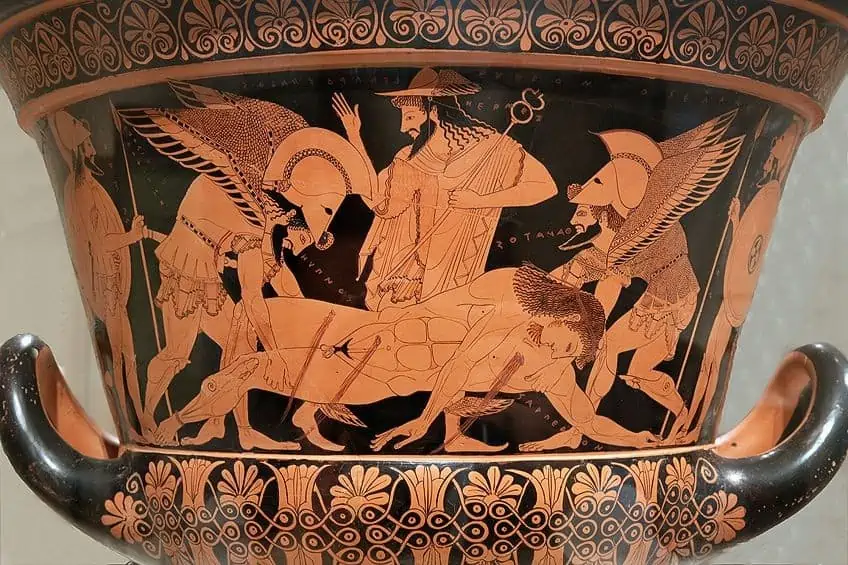Famous Greek Paintings – Learn About Classical Greek Art
Ancient Greece has been the site of study for many disciplines, including archaeology, architecture, and art. The art of ancient Greece offers much insight into the lives and historical events of the people who once made them. The culture of the ancient Greeks relied heavily on mythological legends and cultural narratives to guide their art practices, which were also intertwined with a preference for ornamental decoration and grandeur, later adopted by the Romans. This article will provide you with all you need to know about the most famous Greek paintings of all time.
Contents
- 1 Greek Art: The Significance of Greek Paintings
- 2 Popular Ancient Greek Painters
- 3 Top 12 Most Famous Ancient Greek Paintings
- 3.1 Painted Limestone Funerary Stele (4th – 3rd Century BC)
- 3.2 Terracotta Loutrophoros (4th Century BC) by Metope Painter
- 3.3 Terracotta Pyxis (465 – 460 BC) by the Penthesilea Painter
- 3.4 Nekyia (c. 480 BC) by Polygnotus
- 3.5 The Kachrylion Kylix (c. 510 BC) by Kachrylion
- 3.6 The Euphronios Krater (c. 515 BC) by Euphronios and Euxitheos
- 3.7 Amphora (c. 540 BC) by Exekias
- 3.8 Christ Bearing the Cross (15th Century) by Nicolaos Tzafouris
- 3.9 Christ Healing the Blind (1570) by El Greco
- 3.10 Head of the Virgin (c. 1636 – 1690) by Emmanuel Tzanès
- 3.11 Cardinal Fernando Niño de Guevara (c. 1600) by El Greco
- 3.12 The Akrotiri Boxer Fresco (c. 1700 BC)
- 4 Frequently Asked Questions
Greek Art: The Significance of Greek Paintings
In all the beauty, stories, and history of antiquity and Classical Greek art, what can be said about its value and significance today? What was significant about Greek paintings? The Greek arts offer tons of insight into the culture and life of ancient Greek civilization. The Greeks utilized painting in a variety of ways that included its use in ceremonial buildings, homes, tombs, and public buildings.
Due to the nature of early Greek art, many paintings have perished due to natural disasters, looting, and vandalism.
Aesthetics
The act of painting in ancient Greece was also important in maintaining aesthetics and keeping a sense of pride in the everyday environment. Murals were often used to conceal imperfections in architecture and decorate uneven surfaces. Greek paintings also indicate the level of balance that the Greeks held concerning their culture.
Mathematical proportions were also included in painting to maintain that sense of equilibrium despite the uneven surfaces of some structures.
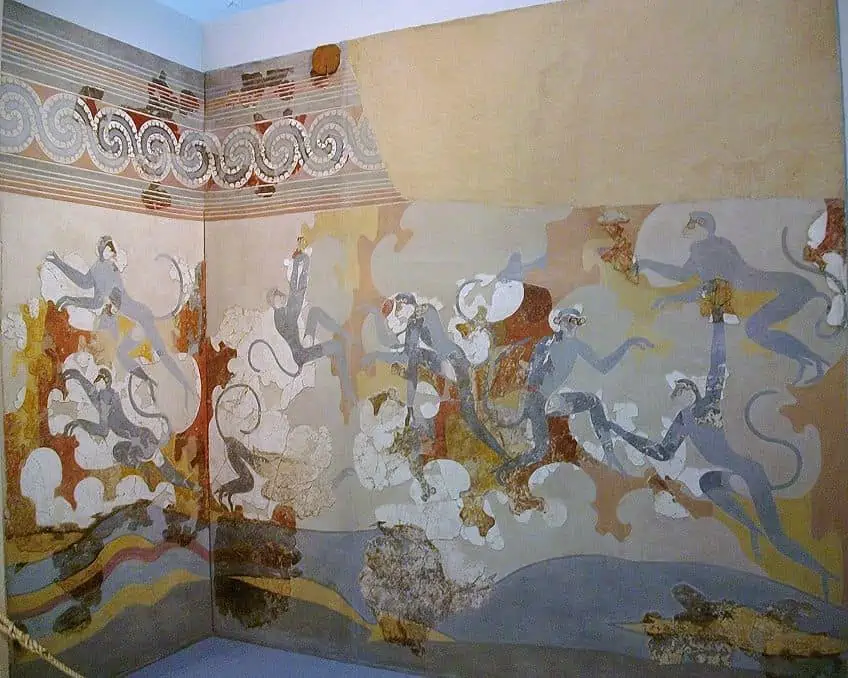
Painting did not only occur on flat surfaces and empty vessels; it was also a decorative act for sculptures. Many stone sculptures were also painted in vivid colors on different parts of statues, usually to highlight the hair, clothing, or specific body parts. Classical Greek art saw the emergence of pictorial forms in painting along with the tempera and encaustic painting techniques.
Beauty and Influence
Insights that we can draw from Greek art also involve the development of beauty and the different canons through which it was looked at. The representation of beauty in heroic figures and deities has provided insight into the value of proportions and other elements of art found in painting.
There is much rationality in Greek art as seen through the lack of nervous lines in many paintings and the confidence in the different characters of Greek mythology.
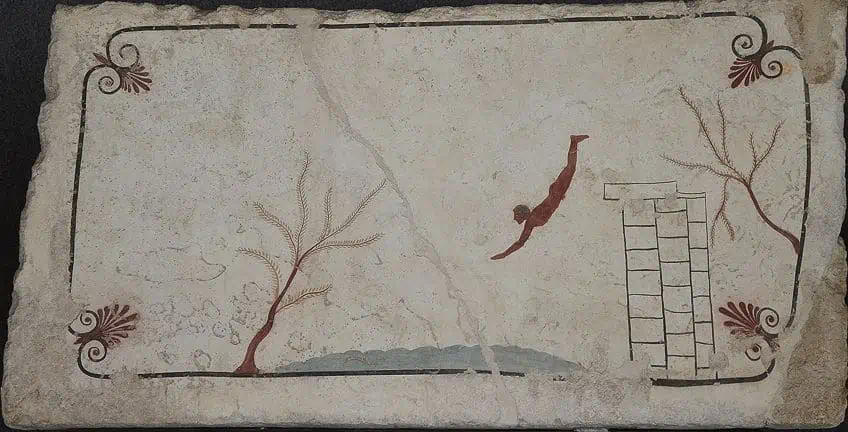
The significance of Greek art also lies in its influence. Greek art was incredibly influential to the Romans who held a strong appreciation for many Greek artworks, especially during the reign of the Roman Empire. Many imitations of Greek-styled art were produced in Rome to decorate public spaces, temples, and global colonies.
Variety in Subject Matter
While ancient Greece was responsible for major developments in sculpture and pottery, painting was the next major discipline that propelled some of the greatest Greek artists. The Hellenistic period in ancient Greece, which was marked by the passing of Alexander the Great around 323 BC, was also the period that marked a deeper appreciation for painting in Greece.
Popular subjects in Greek painting include the figure of Medusa with a snake-infested head, Olympic athletes, Gods, centaurs, and dancing women.
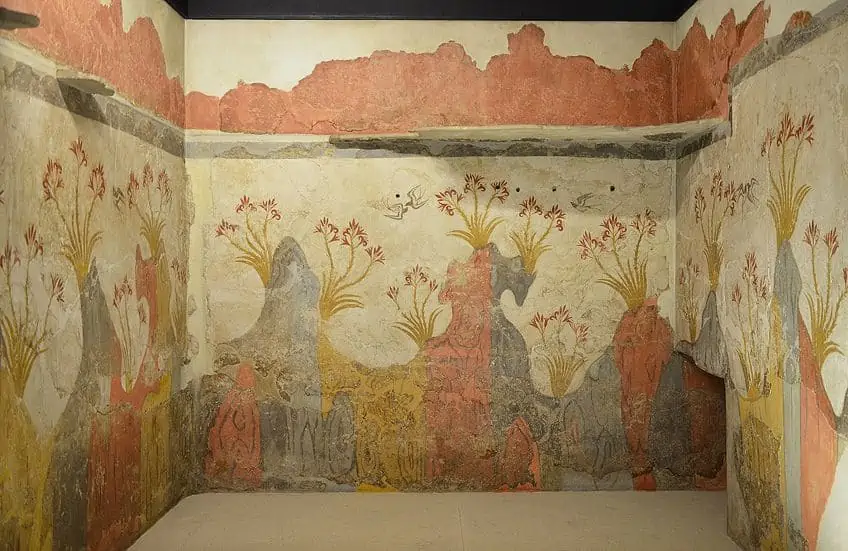
A Greek painter by the name of Zeuxis laughed so hard at one of his artworks that he died from a broken blood vessel. The surviving works of ancient Greek painting are unfortunately very slim. There are almost zero surviving Greek paintings or murals and the majority of what historians know about Greek painting are derived from texts with descriptions.
The remaining paintings that have survived the test of time and natural disasters include artwork from vases and pottery made in the Archaic age, between 500 and 700 BC.
Popular Ancient Greek Painters
Of the many Greek painters whose works are non-existent to date, Parrhasius of Athens was regarded as one of the most famous artists of the 5th century. Parrhasius used subtle contours instead of the heavy chiaroscuro painting technique to depict the human form and was praised for his talent in outline drawing. Parrhasius was more interested in portraying the psychology behind the human face and its different expressions. He often made work using parchment or wood and was an inspiration to many Greek artists to follow. Unfortunately, none of his copies or original artworks survived. Other notable ancient Greek painters are listed in the table below:
| Artist Name | Years Alive | Place of Birth | Medium/Specialty/Artworks |
| Heraclides | 2nd century (c. 168 BC) | Macedonia, Greece | Hot wax painting, marine painting, seascapes |
| Echion of Amphipolis | late 4th – early 3rd Centuries) | Amphipolis, Macedonia, Greece | Painting, sculpture, wood engraving |
| Artemon | c. 300 BC | Greece | Painting; mythological subject matter |
| Apelles of Kos | (352 – 308 BC | Colophon, Ionia | Painting: ● Alexander Wielding a Thunderbolt (c. unknown) ● Aphrodite Anadyomene (c. unknown) ● Portrait of Antigonus I Monophthalmus on Horseback (c. unknown) ● Portrait of Artemis surrounded by a group of maidens offering a sacrifice (c. unknown) ● Sacrifice in Cos (c. unknown) ● Portraits of Clitus the Black and Archelaus I of Macedon (c. unknown) ● Procession of the High Priest of Artemis at Ephesus (c. unknown) ● The Great allegory of Calumny (c. unknown) |
| Eupompus | 4th century BC | Sicyon, Greece | Painting |
| Pausias | 4th century BC | Sicyon, Greece | Ceiling painting, encaustic painting ● Portrait of Glycera (Stephaneplocos) (c. unknown) ● A Sacrifice (c. unknown) ● Eros Laying Down (c. unknown) |
| Protogenes | 4th century BC | Kaunos, Anatolia | Painting ● ● The Ialysus (c. unknown) ● The Satyr (c. 305 – 304 BC) ● Alexander and Pan |
| Theon of Samos | 4th century BC | Greece | Painting; theatrical scenes of action |
| Pamphilus | 4th century BC | Macedonia, Greece | Painting; interests in mathematics, painting skills development, and art education |
| Androcydes | 4th century BC | Cyzicus, Mysia, Anatolia | Painting, genre painting, battle scenes ● Battle of Plataea (c. unknown) |
| Euphranor of Corinth | mid-4th century BC | Painting, sculpture, mythological subjects
● Philip and Alexander in chariots (c. unknown) ● Feigned Madness of Odysseus (c. unknown) | |
| Agatharchus | 5th century BC | Samos, Greece | Painting, scenic painting, perspective, Illusionism |
| Apollodorus Skiagraphos | 5th century BC | Athens, Greece | Painting, skiagraphia technique ● Praying Priest (c. unknown) ● Ajax Burned by Lightning (c. unknown) |
| Zeuxis | 5th century BC | Heraclea, Basilicata | Painting, nature, still life, Realism ● Helen (c. unknown) ● Zeus Enthroned (c. unknown) ● The Infant Hercules Strangling the Serpents (c. unknown) |
| Polygnotus | mid-5th century BC | Thasos, Greece | Painting ● Frescoes at the Lesche of the Knidians in Delphi |
| Cimon of Cleonae | 525 – 500 BC | Cleonae | Painting, drawing, portraiture |
Top 12 Most Famous Ancient Greek Paintings
While not many paintings on wood or panel remain from the antiquity era, numerous vase paintings give us an indication of the skill of the early artists and subject matter preferences of the time. Below, we have provided a list of the top 12 most famous Greek paintings of all time that showcase the artistic breadth of Greek antiquity.
Painted Limestone Funerary Stele (4th – 3rd Century BC)
| Artist | Unknown |
| Date | Early 3rd – late 4th century BC |
| Medium | Limestone; paint |
| Dimensions (cm) | 74.3 x 47.6 |
| Where It Is Housed | The Metropolitan Museum of Art, New York, United States |
Painted during the Hellenistic period in ancient Greece, this limestone stele depicts a man with ochre-colored skin and a pale-yellow garment seated in the middle on a raised stool. It is believed that the man is in the position of a farewell gesture with his hands joined to a tall woman wearing a pale chiton and himation.
Behind the man is another man dressed in a violet himation. The background space is divided into two vertical portions with gray on the left and violet on the right.
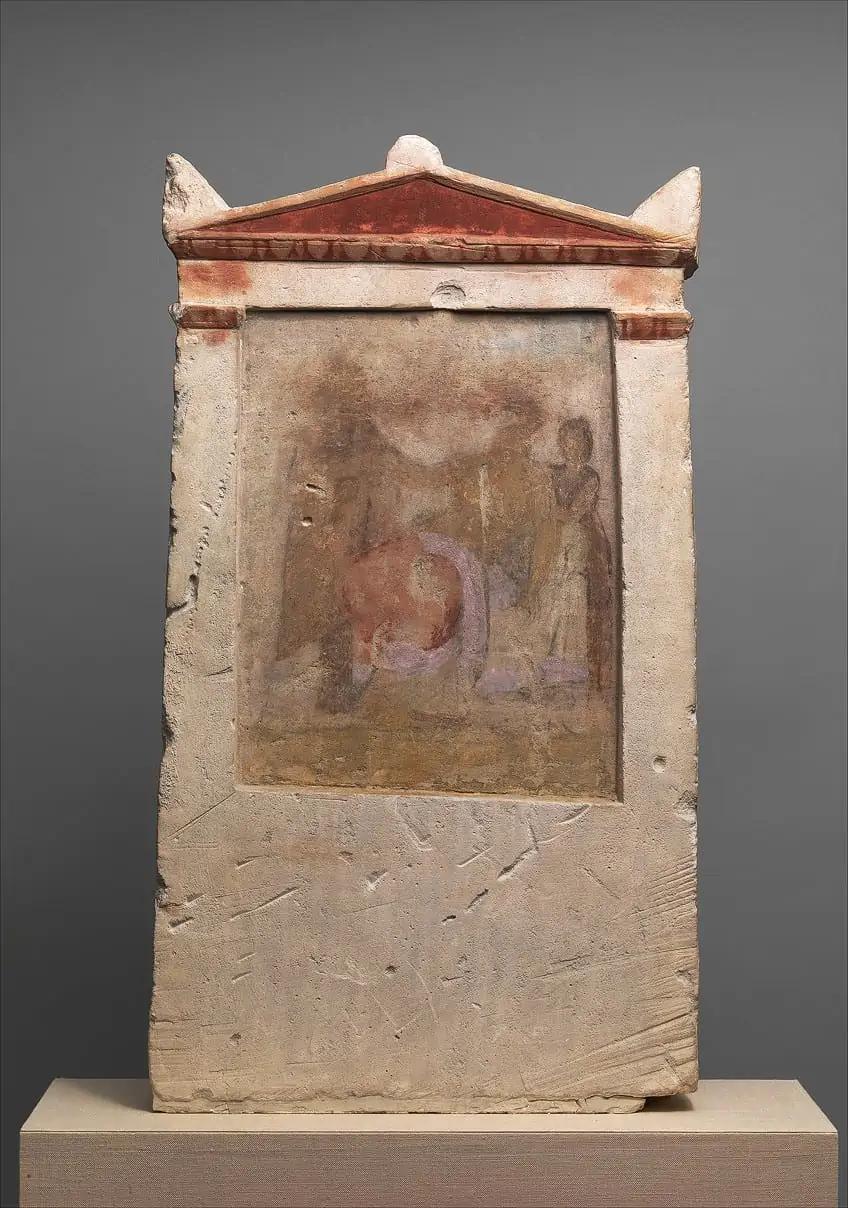
The balanced and calm nature of the composition originated from grave relief artwork of the 4th century BC. This stele was originally found lying against the wall of an underground tomb but its structure suggests that it was intended for lodging in a base above the ground.
While not many details remain on the painting, experts have illuminated the underlying details as best as they could and one can even view the surviving layers of the drapery on the female figure.
Terracotta Loutrophoros (4th Century BC) by Metope Painter
| Artist | The Metope painter (c. 4th century BC) |
| Date | Third quarter of 4th century BC |
| Medium | Terracotta; red-figure |
| Dimensions (cm) | 88.3 |
| Where It Is Housed | The Metropolitan Museum of Art, New York, United States |
This Terracotta Loutrophoros is an example of Late Classical Greek art and was a vessel used in ancient Greek ceremonies to carry water. The artist credited for this vase painting is a Metope painter, whose details remain unknown.
The vase itself portrays a woman surrounded by youth and women as well as Eros with an alabastron (long flask).
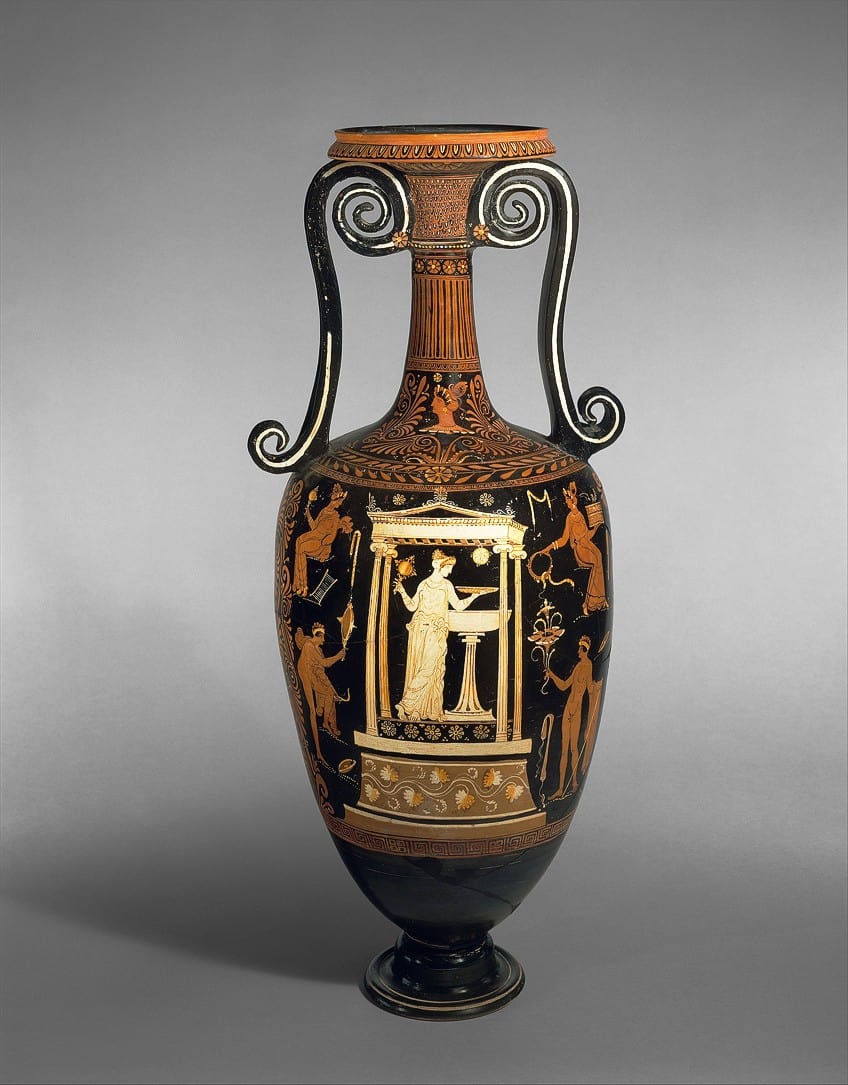
The podium contains triglyphs that alternate with metopes that showcase Greeks fighting the Amazons. A small naiskoi (temple) is seen enclosing a woman, yet the mystery remains concerning the representation of funerary structures and limestone reliefs.
Terracotta Pyxis (465 – 460 BC) by the Penthesilea Painter
| Artist | Credited to the Penthesilea painter (active dates between c. 470 – 450 BC) |
| Date | c. 465 – 460 BC |
| Medium | Terracotta; white-ground |
| Dimensions (cm) | 17.2 (h) |
| Where It Is Housed | The Metropolitan Museum of Art, New York, United States |
This famous Greek painting on a 5th-century vase portrays the traditional scene of the judgment of Paris. The judgment of Paris is a narrative from Greek mythology that revolves around the events that led up to the Trojan War and the founding of Rome. The story describes the account of Eris, the Goddess of discord who was not invited to Peleus’ and Thetis’ wedding and sought revenge for her exclusion.
Eris enacted her revenge by tossing a golden apple into the wedding with the inscription “to the fairest one”.

The three goddesses, Aphrodite, Hera, and Athena selected Paris of Troy to choose the fairest deity. Paris ended up choosing Aphrodite through a bribe and agreement to give Helen of Sparta to him, who was the most beautiful woman in the world and the wife of Menelaus. This was to be the cause of the Trojan War since Paris took Helen to Troy, resulting in the invasion of Troy by the Greeks.
The vase, crafted using the white-ground technique, was a common element in vases used for grave sites and came in different shapes.
Classical Greek painters began to explore polychromy in painting with the introduction of the white background and its ability to emphasize the glaze lines. The decoration on the pyxis (box) resembles the artwork of the famous Greek Penthesilea painter, who often depicted traditional subjects in this manner.
Nekyia (c. 480 BC) by Polygnotus
| Artist | Polygnotus (500 – 440 BC) |
| Date | c. 480 BC; actual date unknown |
| Medium | Various pigments: black, white, red, and ochre |
| Dimensions (cm) | Dimensions unavailable |
| Where It Is Housed | Reconstructed images in Die Nekyia des Polygnot (1892) by Carl Robert. |
The turn of the Archaic Greek period around 500 BC saw the emergence of the human body in sculpture and painting. This was seen as the first major move toward illusionism and was practiced by one of the greatest Greek masters, Polygnotus of Thasos.
Polygnotus was a popular painter who specialized in large-scale Classical Greek art.

While there are no remains of his original work, Carl Robert published reconstructions of Polygnotus’ best works, one of which can be seen above as Neykia. It is believed that Polygnotus produced most of his work from around 480 BC and employed a simple color palette of black, white, red, and ochre.
Polygnotus’ depiction of human figures was admired for their character and was even remarked upon by Pliny who credits him with different innovations in vase painting and composition.
The Kachrylion Kylix (c. 510 BC) by Kachrylion
| Artist | Kachrylion, Oltos, or Euphronios (c. 5th – 6th century BC) |
| Date | c. 510 BC |
| Medium | Terracotta; red-figure |
| Dimensions (cm) | Dimensions Unavailable |
| Where It Is Housed | On loan to the Metropolitan Museum of Art from the Museo Archeologico Nazionale, Florence, Italy |
This Kylix (drinking cup) is one of the remaining artifacts from ancient Greece that marks the height of trade and development in Athens and the export boom with Italy. This famous Greek painting on the cup was most likely created by Oltos or Euphronios, who worked with the potter of this cup, Kachrylion. The painted image on the cup portrays Eros holding a lotus tendril mid-flight. The cup first saw the light of day in 1882 at a cemetery in Orvieto.
The interior scene of the cup is incredible and shows Eros, who is the God of love, flying with a lotus tendril in his hand.
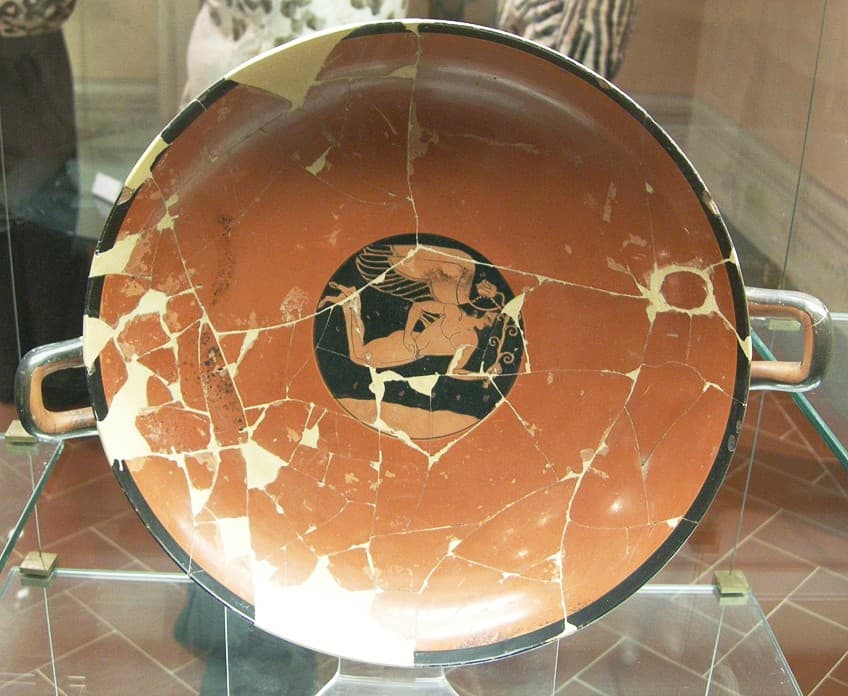
According to the traditional story, Eros flies over the sea, which refers to the birth of his mother Aphrodite from the ocean. Recent narratives place Eros between the sky and earth as an intermediary between the mortal and divine worlds. The outer layer of the cup portrays a cyclical depiction of the acts performed by Theseus (hero and founder of Athens) on his journey to Athens from Troizen.
His heroic efforts are portrayed through his encounter with a minotaur at Crete, beginning with Theseus bending a pine tree to blind Sinis. He then overpowers the beast and is finally seen attempting to shorten Prokrustes to fit the length of his bed.
A Prokrustes in Greek mythology refers to a rogue smith or bandit from Attica who harmed people by cutting off their legs or forcefully stretching them to make them fit into an iron bed. The other section of the cup shows Theseus wrestling Cercyon (a cruel King of Eleusis) and upending Sciron (a popular Corinthian bandit) into the sea. According to Greek antiquity, Theseus was responsible for ridding Athens of any bandits or “malefactors” and helped transform Athens into a unified political entity.
The Euphronios Krater (c. 515 BC) by Euphronios and Euxitheos
| Artist | Euphronios (535 – 470 BC) and Euxitheos (date of birth unconfirmed) |
| Date | c. 515 BC |
| Medium | Terracotta |
| Dimensions (cm) | 45.7 x 55.1 |
| Where It Is Housed | Archaeological Museum of Cerveteri, Cerveteri, Italy |
The Euphronios Krater also referred to as the Sarpedon Krater, is a calyx-krater pot from ancient Greece used to mix wine and water. The bowl was created around 515 BC and is known to be one of the last 27 surviving painted vases crafted by one of the most popular Greek painters, Euphronios. The Euphronios Krater was initially part of an illegal excavation near Cerveteri, which later made its way to the Metropolitan Museum of Art in New York. The vase was repatriated in 2008 to Italy and is currently housed at the Archaeological Museum of Cerveteri.
The vase is painted with two scenes; a scene from the Trojan war on the obverse, which portrays the death of Sarpedon, and a scene on the reverse, which shows Athenian youths arming themselves in preparation for a battle.
The scene depicting Sarpedon’s death illustrates Hermes instructing Hypnos and Thanatos (each of whom is a personification of sleep and death, respectively) to carry Sarpedon away for burial in his hometown. Euphronios painted the figures with very high attention to bodily anatomy and naturalistic poses as opposed to the traditional stylized tableau that was often used to depict Sarpedon’s death.
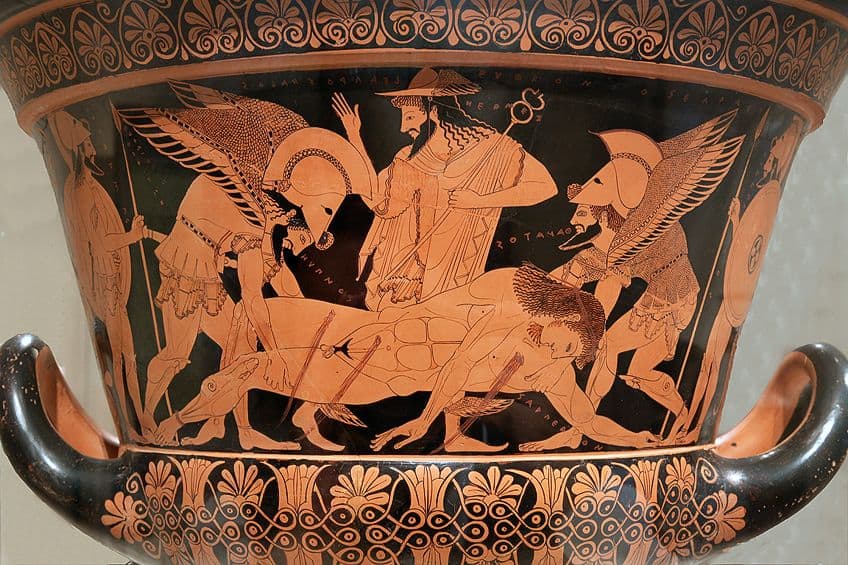
The naturalistic approach and spatial illusion in painting were championed by a small group of Late Archaic painters of whom Euphronios was a member. Euphronios Krater is also a Contemporary painting for its depiction of the anonymous youth taking up arms for war. They are not specific heroes as in the scene of Sarpedon’s death but they are given details that demonstrate their characters and could have been individuals from the Greek army.
The two scenes placed next to each other encourage audiences to ponder the ways in which the two stories may relate and influence each other.
It is said that perhaps sleep and death, which carried Sarpedon away may have been a premonition for the fate of the young soldiers. It was uncommon for an artist to sign their name on an artwork, and this vase was one such example of that rare occurrence. Euphronios signed his name alongside the potter Euxitheos. It is speculated that he did this since he believed that this painting was one of his finest works. The vase is also inscribed with the statement “Leagros is handsome”. Leagros was a man considered to be the most handsome in all of Greece at the time.
Amphora (c. 540 BC) by Exekias
| Artist | Exekias (545 – 525 BC) |
| Date | c. 540 BC |
| Medium | Pottery |
| Dimensions (cm) | 44.45 (h) |
| Where It Is Housed | The British Museum, London, England |
This pot contains one of the most famous Greek paintings of all time by one of the most famous painters, Exekias. An amphora is a special kind of vase with a pointed bottom and unique shape that was frequently used as a storage vessel for various products, including wine. This uniquely painted amphora was created by Exekias, an Athenian black-figure painter who was an excellent draftsman, potter, and painter.
Exekias is believed to have introduced new ways of depicting traditional mythological scenes on vases and intricately drawn on scenes in such a way that they not only served as decor but they were also embedded with powerful emotions.
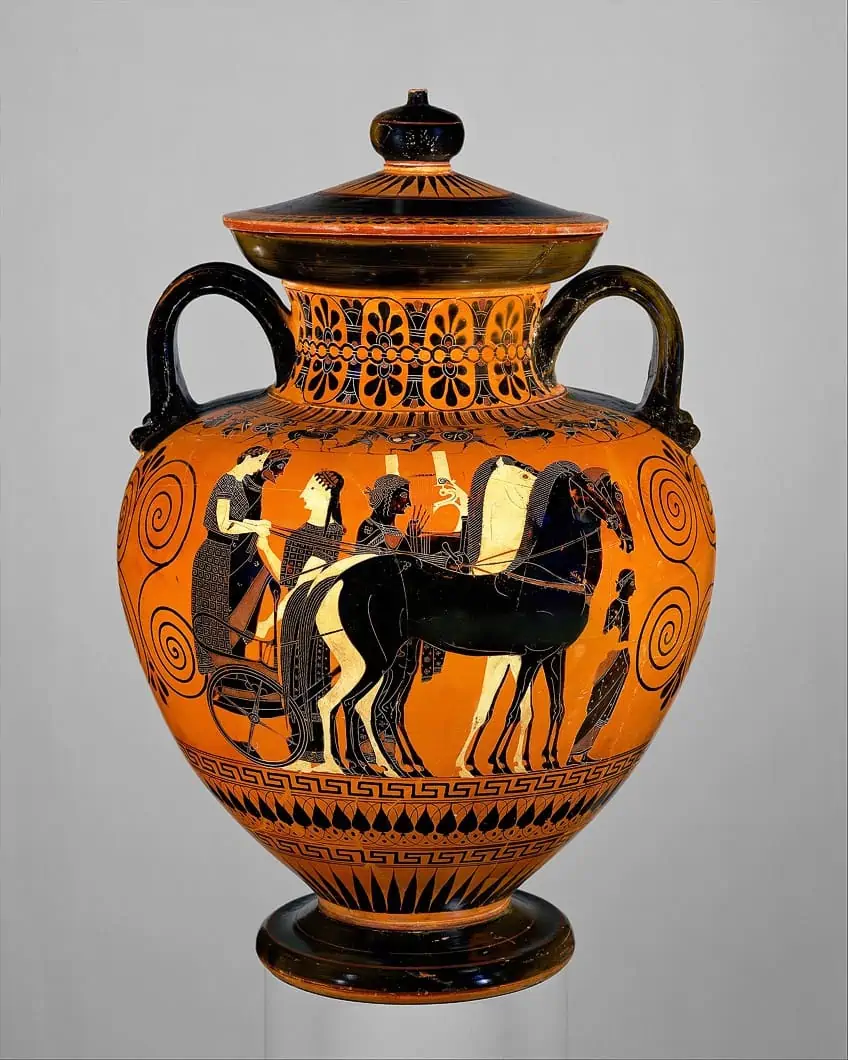
The designs on this amphora feature black figures on red panels with a honeysuckle and lotus border. The scenes depicted on the amphora include Hermes slaying Argos at the center and holding a sword in his hand. Argos is portrayed with a double head, which is a reference to Janus. Both figures have been partially restored with Hera seen behind Hermes to the left with her arms extended.
Another scene on the vase is a fight between Heracles and the Amazons. The left portrays an Amazon believed to be Alkaia wearing a short chiton and equipped with a Boeotian shield and spear.
Heracles is donned in a lion’s skin over his head as he is about to drive his sword into the other Amazon called Andromache. The right side of this scene portrays the warrior Telamon with a short chiton, a visored helmet, and a shield. The Amazons are also depicted with white skin in contrast to the black figures.
Christ Bearing the Cross (15th Century) by Nicolaos Tzafouris
| Artist | Nicolaos Tzafouris (c. 1455 – 1500/1501) |
| Date | c. 15th century |
| Medium | Oil, tempera, and gold ground on wood |
| Dimensions (cm) | 69.2 x 54.6 |
| Where It Is Housed | Metropolitan Museum of Art, New York, United States |
Christ Bearing the Cross is one of the best Greek artworks of the 15th century by Nicholaos Tzafouris who was known to be an iconic painter of Crete. Tzafouris integrated both Latin and Byzantine elements in his painting, which was a feature of Cretan artwork that was well-received both locally and in Italy.
The painting is inscribed with a Byzantine icon that details how soldiers drag Jesus Christ to Golgotha.

The scene in the painting, however, shows Christ dragging a cross to Golgotha and was characteristic of many Western paintings. The soldier in front of Christ is seen dressed in contemporary-styled Italian armor while the rest of the soldiers wear Cretan or Byzantine armor.
Christ Healing the Blind (1570) by El Greco
| Artist | Domenikos Theotokopoulos, or El Greco (1541 – 1614) |
| Date | 1570 |
| Medium | Oil on canvas |
| Dimensions (cm) | 119.4 x 146.1 |
| Where It Is Housed | Metropolitan Museum of Art, New York, United States |
El Greco was a painter, architect, and sculptor who was granted the nickname “El Greco” meaning “The Greek” under the Spanish Renaissance. The artist was born in the Kingdom of Candia, presently known as Crete, and was exposed to the hub of post-Byzantine-era art.
He is celebrated for being one of the most unique artists of his time, made famous in painting for his elongated figures and phantasmagorical application of color, which reflected his interest in combining Western painting with Byzantine traditions.
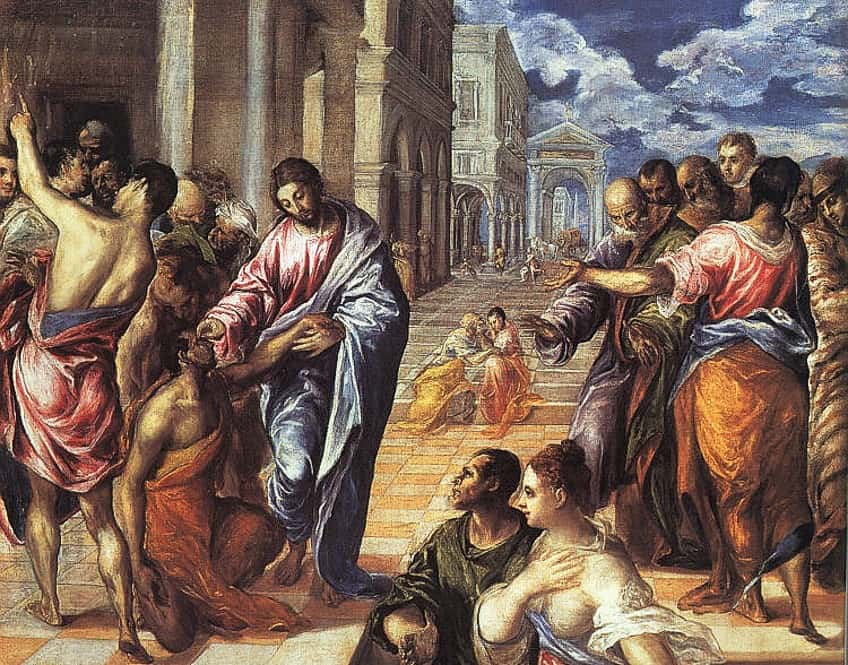
Created in 1570, Christ Healing the Blind is one of the most famous Greek paintings in art history that portrays the dramatic narrative of the Gospel account of Jesus Christ anointing a blind man and healing his eyes. The two individuals in the foreground are believed to be the man’s parents. While the painting remains unfinished, it is still considered a masterpiece in the making.
El Greco did go on to paint two other versions with the same subject but none were as captivating as this version.
Head of the Virgin (c. 1636 – 1690) by Emmanuel Tzanès
| Artist | Emmanuel Tzanès (c. 1636 – 1690) |
| Date | c. 1636 – 1690 (no confirmed date available) |
| Medium | Tempera and gold ground on wood |
| Dimensions (cm) | 21.3 x 18.1 |
| Where It Is Housed | Metropolitan Museum of Art, New York, United States |
Inscribed on the back of this famous Greek painting is Mary, Mother of God made by a post-Byzantine artist, Emmanuel Tzanès sometime in the mid-1600s. This small wooden panel contains the image of Mary rendered in incredible detail alongside Christ and the head of Saint John the Baptist.
The poses and dressing of the figures reveal the traditional style of the Byzantine era and their halos indicate influences from the West.

Cardinal Fernando Niño de Guevara (c. 1600) by El Greco
| Artist | Domenikos Theotokopoulos, or El Greco (1541 – 1614) |
| Date | c. 1600 |
| Medium | Oil on canvas |
| Dimensions (cm) | 170.8 x 108 |
| Where It Is Housed | Metropolitan Museum of Art, New York, United States |
This striking image of Cardinal Fernando Niño de Guevara was painted around the Spring of 1600 by El Greco, who had just been exposed to the works of Titian at the time. Such exposure to portraits by Titian would have helped El Greco in his discovery of the endless potential of the art of portraiture. The painting illustrates the portrait of the cardinal dressed in his traditional attire. Around 1599, Guevara was elected Inquisitor General of Spain but resigned to serve as an Archbishop of Seville for the rest of his days.
The setting is said to be Toledo and was most likely painted amidst the Madrid court with Philip III.
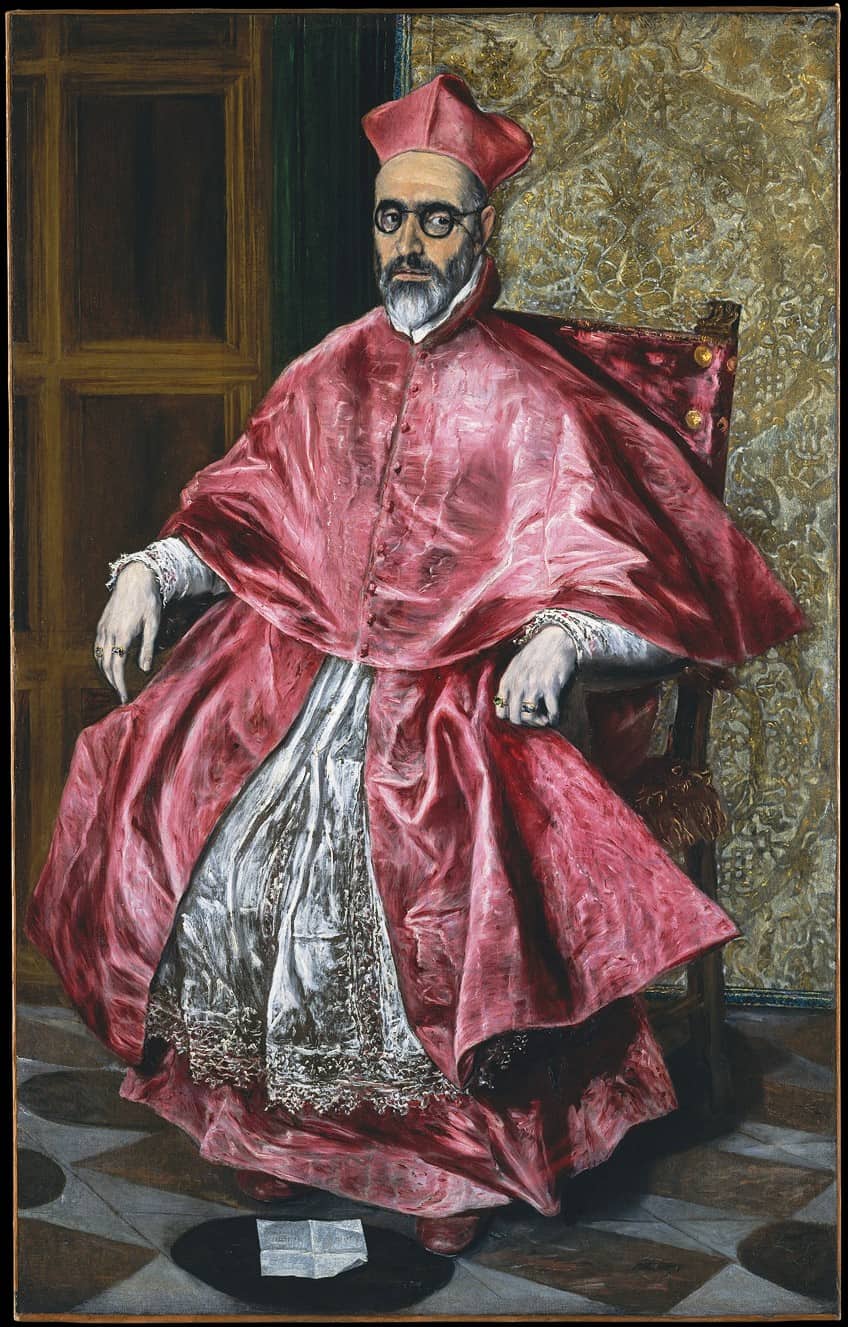
The Akrotiri Boxer Fresco (c. 1700 BC)
| Artist | Unknown |
| Date | c. 1700 BC |
| Medium | Fresco |
| Dimensions (cm) | 155 (l) |
| Where It Is Housed | Wall paintings of Thera, Akrotiri, Santorini, Greece |
Discovered in 1967, this fresco in Akrotiri, Santorini is one of the most famous Greek paintings to survive one of the largest volcanic eruptions on the island. This fresco is one of a few other Minoan frescoes and is referred to as the Akrotiri Boxer Fresco for its depiction of a Minoan boxing sports scene. The scene contains two young wrestlers wearing belts and gloves. Around 1600 BC, an earthquake broke out on Santorini causing a volcanic eruption that engulfed the island in a thick layer of ash and pumice. This massive historical event resulted in the rapid preservation of some of the frescoes, including this one.
One of the young men in the painting is seen wearing jewelry, which indicates that he was probably of a higher rank than his opponent.

Artists of ancient Greece created frescoes like this by applying lime plaster over the walls and covering them with brightly-pigmented paint. The Akrotiri Boxer Fresco is also famous for being the first fresco from ancient Greece to depict a sports-related deformity. Upon inspection by a medical writer, it appears that the boy on the right suffered from spondylolisthesis. Spondylolisthesis refers to a condition involving the displacement of a single spinal vertebra (either forward or anterior) over the vertebrae below it.
However, it is argued that most Minoan paintings were not very accurate and this may have simply been the painting style of the artist.
Minoan art involved the use of a technique called fresco-secco, which after the application of plaster and after the first layer of paint dried, an artist would add extra details using a binding agent. Common colors used in Minoan frescoes include white, yellow, red, blue, black, and green extracted from minerals and processed using organic material. In other examples of Greek art, red was used to represent the skin of a male while white was used to represent a woman.
Ancient Greek paintings offer a rich source of insight into the legends, lifestyles, social practices, and artistic preferences of ancient Greek civilizations. Greek artwork has inspired many well into the 21st century and has influenced many parts of the world. Of these ancient Greek paintings, which is your favorite?
Take a look at our ancient Greek paintings webstory here!
Frequently Asked Questions
What Was Significant About Greek Paintings?
Greek paintings were significant in their respective periods for various reasons that include ceremonial, funerary, decorative, and artistic purposes. Greek paintings also served as a physical manifestation of deities and Gods from Greek mythology. Greek art also influenced Roman culture and was adopted and appreciated by many colonies under the Roman Empire.
What Were the Ancient Greek Arts Made Up Of?
The ancient Greek arts were made up of architecture and design, of which the talents of many Greek architects can be seen in the remaining temples and buildings. The Greek arts also include sculpture, pottery, and painting, all of which emphasize proportion, traditional mythological narratives, and perspective in their visual construction. Drawing is also on the list of Greek arts but it is considered one of the perishable arts alongside painting.
Who Was the Most Famous Greek Painter?
The most famous Greek painter is considered to be Parrhasius of Athens, who was popular throughout the 5th century. Parrhasius was admired for his outline drawings and subtle approach to visual aesthetics as opposed to the chiaroscuro method of emphasizing the weight of the human body.
Jordan Anthony is a Cape Town-based film photographer, curator, and arts writer. She holds a Bachelor of Art in Fine Arts from the University of the Witwatersrand, Johannesburg, where she explored themes like healing, identity, dreams, and intuitive creation in her Contemporary art practice. Jordan has collaborated with various local art institutions, including the KZNSA Gallery in Durban, the Turbine Art Fair, and the Wits Art Museum. Her photography focuses on abstract color manipulations, portraiture, candid shots, and urban landscapes. She’s intrigued by philosophy, memory, and esotericism, drawing inspiration from Surrealism, Fluxus, and ancient civilizations, as well as childhood influences and found objects. Jordan is working for artfilemagazine since 2022 and writes blog posts about art history and photography.
Learn more about Jordan Anthony and about us.
Cite this Article
Jordan, Anthony, “Famous Greek Paintings – Learn About Classical Greek Art.” artfilemagazine – Your Online Art Source. November 15, 2022. URL: https://artfilemagazine.com/famous-greek-paintings/
Anthony, J. (2022, 15 November). Famous Greek Paintings – Learn About Classical Greek Art. artfilemagazine – Your Online Art Source. https://artfilemagazine.com/famous-greek-paintings/
Anthony, Jordan. “Famous Greek Paintings – Learn About Classical Greek Art.” artfilemagazine – Your Online Art Source, November 15, 2022. https://artfilemagazine.com/famous-greek-paintings/.


